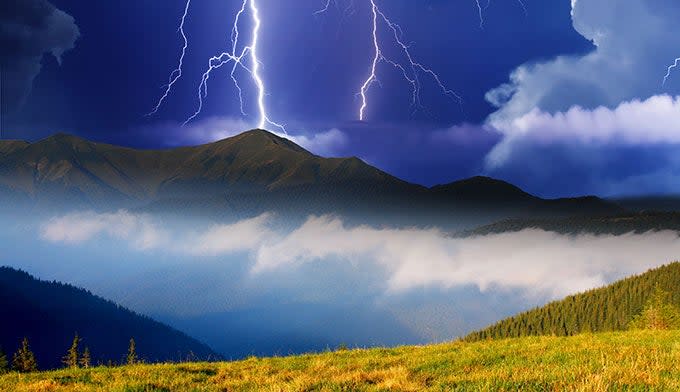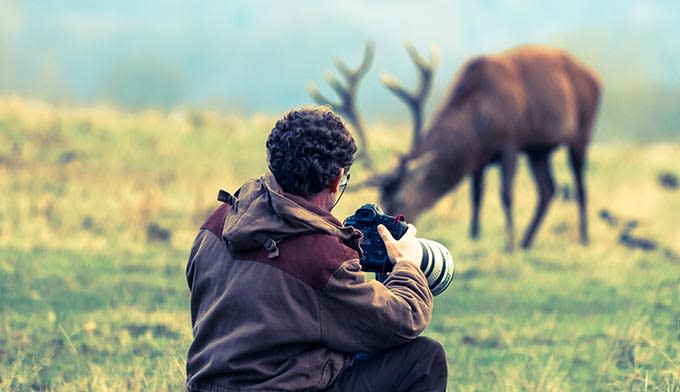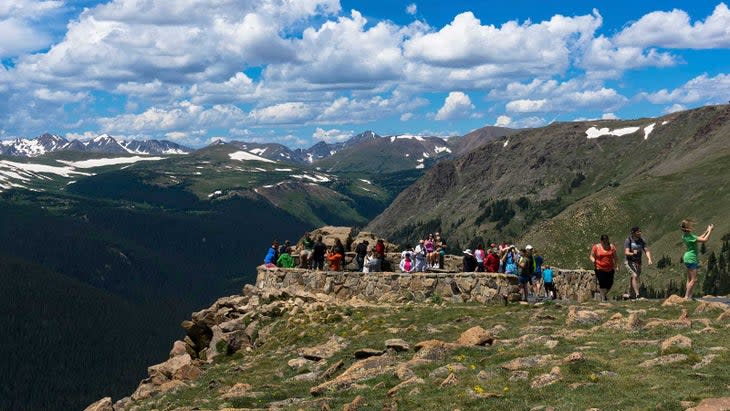3 Places Not to Take Selfies in Rocky Mountain National Park
This article originally appeared on My Colorado Parks
Rocky Mountain National Park had more than 4.4 million visitors in 2021. But just because it's popular doesn't mean it’s not dangerous. Don't get so carried away with the magnificent mountain views that you leave your common sense behind, especially when you are trying to get the ultimate selfie.
Every year, people get injured in Rocky Mountain National Park, often without them fully comprehending the danger associated with what they were doing. Here are three places not to take a selfie, followed by suggestions on how to get the safer shot. Note that in 2022, you need a separated timed-entry pass to enter the park, in addition to a park pass.
1. Don’t Pose on a Mountain Peak in the Park in the Afternoon

Lightning is a threat at Rocky Mountain National Park’s high elevations during the afternoon. While some park visitors like the idea of summiting a mountain peak and having the selfie to prove it, don’t start the long hike up Longs Peak (or any peak for that matter) too late in the day. You may get caught in a thunderstorm.
Numerous injuries and deaths have occurred in the park from lightning strikes. In July 2014, there were two separate lightning strike deaths just 24 hours apart from each other. The first strike killing a woman, Rebecca Teilhet, and injured seven others. The next strike, a little over 24 hours later, killed a man, Gregory Cardwell, and injured 12 others. According to USA Today, a total of 21 people were injured and sent to the hospital because of that weekend's lightning strikes.
Even driving on a high-elevation road can be hazardous. Although Trail Ridge Road is an exciting drive, do not get out of your car to get a better photo of an encroaching thunderstorm. Lightning injuries and deaths have occurred from motorists stopping during thunderstorms and climbing up nearby hills to snap pictures.
Better idea:
Plan to make the mountain summit in the morning and keep an eye on the weather. Snap that summit photo and then get down from the mountain peak long before afternoon thunderstorms hit. No summit picture is worth your life.
If you are caught in a thunderstorm while driving, stay inside the car with your windows rolled up to take your photos.
2. Don’t Pose Too Close to Wild Animals

During your hike or family outing in Rocky Mountain National Park, you may stumble upon a group of grazing elk or even see a bear from a distance. It is very important to realize that these animals are wild. Do not get close when trying to snap a photo of the animals. Remember to keep your distance of at least 25 yards between you and an elk or moose. You should have 100 yards between you and a bear. A selfie or close-up shot could put you in danger. The park's animals are not behind fences or in cages and can charge and seriously injure those trying to photograph them too closely.
Elk have been known to charge people during breeding season in the fall months. In September 2015, a tourist just outside of Rocky Mountain National Park in Estes Park was gored by an elk after standing in the middle of a herd. He did survive.
Better idea:
Remember to keep your distance of at least 25 yards when getting the perfect shot of Rocky Mountain wildlife. With bears or mountain lions, it is at least 100 yards to be a safe distance away when taking pictures or observing.
3. Don’t Pose Too Close to the Edge

Rocky Mountain National Park has numerous overlooks strategically placed to give you the best views. These places are the best for taking selfies with impressive backgrounds. But don’t be tempted to climb over rock walls and fences along the edge. There’s no net to catch you if you slip.
Many of the park’s 350 miles of hiking trails also meander along cliff edges. The idea of a photo of yourself as you dangle above an abyss is enticing but people have died doing these stunts or simply from slipping.
Longs Peak alone has chalked up a total of 63 deaths since 1921, making it one of the deadliest fourteeners in the Rocky Mountain Range. In 2010, the mountain reached three fatalities for the year when John M. Regan fell 300 feet from The Ledges. His body was recovered by rescuers the same day. That same summer Benjamin Russel Hebb fell to his death at 800 feet while on the Broadway Ledge of Longs Peak. He was a University of Colorado student and an experienced climber as reported by the Estes Park Trail Gazette.
Longs peak averages one death per year, although some years have proven to be more fatal than others. During the years 1999, 2000 and 2010 three or more hikers were killed over the course of the year.
Better idea:
Stay inside overlook boundaries. And when taking a photo along a cliff edge, be sure you are anchored, sure-footed and aware before you focus on getting the shot.
For exclusive access to all of our fitness, gear, adventure, and travel stories, plus discounts on trips, events, and gear, sign up for Outside+ today.
